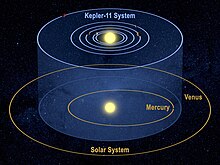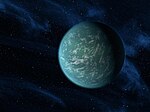 Artist's conception of a simultaneous transit of three planets before Kepler-11 observed by NASA's Kepler space telescope on Aug. 26, 2010. | |
| Observation data Epoch J2000 Equinox J2000 | |
|---|---|
| Constellation | Cygnus |
| Right ascension | 19 48 27.6226 |
| Declination | +41° 54′ 32.903″ |
| Apparent magnitude (V) | 14.2 |
| Characteristics | |
| Spectral type | G6V |
| Astrometry | |
| Proper motion (μ) | RA: 0.106(13) mas/yr Dec.: −7.103(15) mas/yr |
| Parallax (π) | 1.5476 ± 0.0117 mas |
| Distance | 2,110 ± 20 ly (646 ± 5 pc) |
| Absolute magnitude (MV) | 4.7 |
| Details | |
| Mass | 1.042±0.005 M☉ |
| Radius | 1.021±0.025 R☉ |
| Surface gravity (log g) | 4.44±0.02 cgs |
| Temperature | 5836±7 K |
| Metallicity | 0.062±0.007 dex |
| Rotational velocity (v sin i) | 2.2±0.2 km/s |
| Age | 3.2±0.9 Gyr |
| Other designations | |
| KOI-157, KIC 6541920, 2MASS J19482762+4154328 | |
| Database references | |
| SIMBAD | data |
| KIC | data |
Kepler-11, also designated as 2MASS J19482762+4154328, is a Sun-like star slightly larger than the Sun in the constellation Cygnus, located some 2,110 light years from Earth. It is located within the field of vision of the Kepler space telescope, the satellite that NASA's Kepler Mission uses to detect planets that may be transiting their stars. Announced on February 2, 2011, the star system is among the most compact and flattest systems yet discovered. It is the first discovered case of a star system with six transiting planets. All discovered planets are larger than Earth, with the larger ones being about Neptune's size.
Nomenclature and history
Kepler-11 and its planets were discovered by NASA's Kepler Mission, a mission tasked with discovering planets in transit around their stars. The transit method that Kepler uses involves detecting dips in brightness in stars. These dips in brightness can be interpreted as planets whose orbits move in front of their stars from the perspective of Earth. Kepler-11 is the first discovered exoplanetary system with more than three transiting planets.
Kepler-11 is named for the Kepler Mission: it is the 11th star with confirmed planets discovered in the Kepler field of view. The planets are named alphabetically, starting with the innermost: b, c, d, e, f, and g, distinguishers that are tagged onto the name of their home star.

Characteristics
Kepler-11 is a G-type star that is approximately 104% the mass of and 102% the radius of the Sun. It has a surface temperature of about 5836 K and is estimated to have an age of around 3.2 billion years. In comparison, the Sun is about 4.6 billion years old and has a surface temperature of 5778 K.
With an apparent magnitude of 14.2, it is too faint to be seen with the naked eye.
Planetary system
All known planets transit the star; this means that all six planets' orbits appear to cross in front of their star as viewed from the Earth's perspective. Their inclinations relative to Earth's line of sight, or how far above or below the plane of sight they are, vary by a little more than a degree. This allows direct measurements of the planets' periods and relative diameters (compared to the host star) by monitoring each planet's transit of the star. Simulations suggest that the mean mutual inclinations of the planetary orbits are about 1°, meaning the system is probably more coplanar (flatter) than the Solar System, where the corresponding figure is 2.3°.
The estimated masses of planets b - f fall in the range between those of Earth and Neptune. Their estimated densities, all lower than that of Earth, imply that none of them have an Earth-like composition; a significant hydrogen/helium atmosphere is predicted for planets c, d, e, f, and g, while planet b may be surrounded by a steam atmosphere or perhaps by a hydrogen atmosphere. The low densities likely result from high-volume extended atmospheres that surround cores of iron, rock, and possibly H2O. The inner constituents of the Kepler-11 system were, at the time of their discoveries, the most comprehensively understood extrasolar planets smaller than Neptune. Currently, observations do not place a firm constraint on the mass of planet g (<25 ME). However, formation and evolution studies indicate that the mass of planet g is not much greater than about 7 ME.
Kepler-11 planets may have formed in situ (i.e., at their observed orbital locations) or ex situ, that is, they may have started their formation farther away from the star while migrating inward through gravitational interactions with a gaseous protoplanetary disk. This second scenario predicts that a substantial fraction of the planets' mass is in H2O. Regardless of the formation scenario, the gaseous component of the planets accounts for less than about 20% of their masses but for ≈40 to ≈60% of their radii. In 2014, the dynamical simulation shown what the Kepler-11 planetary system have likely to undergone a substantial inward migration in the past, producing an observed pattern of lower-mass planets on tightest orbits. Additional yet unobserved gas giant planets on wider orbit are likely necessary for migration of smaller planets to proceed that far inward.
The system is among the most compact known; the orbits of planets b - f would easily fit inside the orbit of Mercury, with g only slightly outside it. Despite this close packing of the orbits, dynamical integrations indicate the Kepler-11 system has the potential to be stable on a time scale of billions of years. However, it may be approaching instability due to a secular resonance involving b and c. If this happens, b will most likely become eccentric enough that it collides with c.
None of the planets are in low-ratio orbital resonances, in which multiple planets gravitationally tug on and stabilize each other's orbits, resulting in simple ratios of their orbital periods. However, b and c are close to a 5:4 ratio.
There could conceivably be other planets in the system that do not transit the star, but they would only be detectable by the effects of their gravity on the motion of the visible planets (much as how Neptune was discovered). The presence of additional gas giant planets is currently excluded up to orbital radius of 30 AU.
| Companion (in order from star) |
Mass | Semimajor axis (AU) |
Orbital period (days) |
Eccentricity | Inclination | Radius |
|---|---|---|---|---|---|---|
| b | 2.78 −0.66 M🜨 |
0.091±0.001 | 10.3039 −0.0010 |
0.045 −0.042 |
89.64 −0.18° |
1.83 −0.04 R🜨 |
| c | 5.0 −1.35 M🜨 |
0.107±0.001 | 13.0241 −0.0008 |
0.026 −0.013 |
89.59 −0.16° |
2.87 −0.06 R🜨 |
| d | 8.13 −0.66 M🜨 |
0.155±0.001 | 22.6845±0.0009 | 0.004 −0.002 |
89.67 −0.16° |
3.12 −0.07 R🜨 |
| e | 9.48 −0.88 M🜨 |
0.195±0.002 | 31.9996 −0.0012 |
0.012 −0.006 |
89.89 −0.02° |
4.19 −0.09 R🜨 |
| f | 2.43 −0.45 M🜨 |
0.250±0.002 | 46.6888 −0.0032 |
0.013 −0.009 |
89.47±0.04° | 2.49 −0.07 R🜨 |
| g | <25 M🜨 | 0.466±0.004 | 118.3807 −0.0006 |
0.013 −0.009 |
89.87 −0.06° |
3.33 −0.08 R🜨 |
 Relative size and positions of the 6 planets of Kepler-11, and of the innermost Solar System for comparison. The diameters of the planets (but not of the stars) are scaled up by a factor of 50. |
See also
References
- ^ Vallenari, A.; et al. (Gaia collaboration) (2023). "Gaia Data Release 3. Summary of the content and survey properties". Astronomy and Astrophysics. 674: A1. arXiv:2208.00211. Bibcode:2023A&A...674A...1G. doi:10.1051/0004-6361/202243940. S2CID 244398875. Gaia DR3 record for this source at VizieR.
- ^ Lissauer, Jack J.; et al. (2011). "A closely packed system of low-mass, low-density planets transiting Kepler-11". Nature. 470 (7332): 53–58. arXiv:1102.0291. Bibcode:2011Natur.470...53L. doi:10.1038/nature09760. PMID 21293371. S2CID 4388001.
- ^ Bedell, Megan; et al. (2017). "Kepler-11 is a Solar Twin: Revising the Masses and Radii of Benchmark Planets via Precise Stellar Characterization". The Astrophysical Journal. 839 (2). 94. arXiv:1611.06239. Bibcode:2017ApJ...839...94B. doi:10.3847/1538-4357/aa6a1d.
- "Kepler-11". SIMBAD. Centre de données astronomiques de Strasbourg. Retrieved 2018-05-09.
- "2MASS J19482762+4154328". SIMBAD. Centre de données astronomiques de Strasbourg.
- Michael Mewhinney; Rachel Hoover; Trent J. Perrotto (2 February 2011). "NASA's Kepler Spacecraft Discovers Extraordinary New Planetary System". NASA. Archived from the original on 1 February 2020. Retrieved 4 February 2011.
- Fraser Cain (16 September 2008). "How Old is the Sun?". Universe Today. Retrieved 19 February 2011.
- Fraser Cain (September 15, 2008). "Temperature of the Sun". Universe Today. Retrieved 19 February 2011.
- Boyle, Alan (2 February 2011). "Planetary six-pack poses a puzzle". MSNBC Cosmic Log. Archived from the original on 4 February 2011. Retrieved 4 February 2011.
- ^ Lissauer, Jack J.; et al. (2013). "All Six Planets Known to Orbit Kepler-11 Have Low Densities". The Astrophysical Journal. 770 (2). 131. arXiv:1303.0227. Bibcode:2013ApJ...770..131L. doi:10.1088/0004-637X/770/2/131.
- ^ D'Angelo, G.; Bodenheimer, P. (2016). "In Situ and Ex Situ Formation Models of Kepler 11 Planets". The Astrophysical Journal. 828 (1): id. 33 (32 pp.). arXiv:1606.08088. Bibcode:2016ApJ...828...33D. doi:10.3847/0004-637X/828/1/33. S2CID 119203398.
- ^ Naeye, Robert (2 February 2011). "Kepler's Outrageous System of Six Planets". Sky & Telescope. Retrieved 4 February 2011.
- John Matson (2 February 2011). "A Wealth of Worlds: Kepler Spacecraft Finds 6 New Exoplanets and Hints at 1,200 More". Scientific American. Retrieved 20 February 2011.
- T. O. Hands, R. D. Alexander, W. Dehnen, "Understanding the assembly of Kepler's compact planetary systems", 2014
- Hands, T. O.; Alexander, R. D. (2015), "There might be giants: unseen Jupiter-mass planets as sculptors of tightly-packed planetary systems", Monthly Notices of the Royal Astronomical Society, 456 (4): 4121–4127, arXiv:1512.02649, doi:10.1093/mnras/stv2897, S2CID 55175754
- Contreras, A. P. Granados; Boley, A. C. (5 March 2018). "The Dynamics of Tightly-packed Planetary Systems in the Presence of an Outer Planet: Case Studies Using Kepler-11 and Kepler-90". The Astronomical Journal. 155 (3): 139. arXiv:1802.01702. Bibcode:2018AJ....155..139G. doi:10.3847/1538-3881/aaac82. S2CID 56471148.
- Becker, Juliette C.; Adams, Fred C. (2017), "Effects of Unseen Additional Planetary Perturbers on Compact Extrasolar Planetary Systems", Monthly Notices of the Royal Astronomical Society, 468 (1): 549–563, arXiv:1702.07714, Bibcode:2017MNRAS.468..549B, doi:10.1093/mnras/stx461, S2CID 119325005
- Kubyshkina, D.; Fossati, L.; Mustill, A. J.; Cubillos, P. E.; Davies, M. B.; Erkaev, N. V.; Johnstone, C. P.; Kislyakova, K. G.; Lammer, H.; Lendl, M.; Odert, P. (2019). "The Kepler-11 system: Evolution of the stellar high-energy emission and initial planetary atmospheric mass fractions". Astronomy & Astrophysics. 632: A65. arXiv:1910.09877. Bibcode:2019A&A...632A..65K. doi:10.1051/0004-6361/201936581. S2CID 204824003.
External links
- Official release: NASA's Kepler Spacecraft Discovers Extraordinary New Planetary System Archived 2020-02-01 at the Wayback Machine
- YouTube: Animation of Kepler-11 planetary system
- Kepler 11 Planetary System with Orbits and Planet Sizes
- Astronomers Find 6-Pack of Planets in Alien Solar System
- NASA Astronomy Picture of the Day: Six Worlds for Kepler-11 (3 February 2011)
| Kepler-11 system | ||
|---|---|---|
| Stars |  | |
| Planets | ||
| 2011 in space | ||
|---|---|---|
| 2012 » | ||
| Space probe launches |
|    |
| Selected NEOs | ||
| Exoplanets |
| |
| Discoveries | ||
| Novae | ||
| Comets | ||
| Space exploration | ||